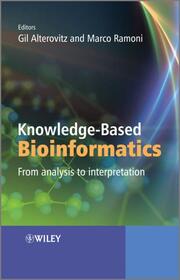Detailansicht
Knowledge-Based Bioinformatics
From analysis to interpretation
ISBN/EAN: 9780470748312
Umbreit-Nr.: 1033429
Sprache:
Englisch
Umfang: 396 S.
Format in cm:
Einband:
gebundenes Buch
Erschienen am 16.07.2010
Auflage: 1/2010
- Zusatztext
- There is an increasing need throughout the biomedical sciences for a greater understanding of knowledge-based systems and their application to genomic and proteomic research. This book discusses knowledge-based and statistical approaches, along with applications in bioinformatics and systems biology. The text emphasizes the integration of different methods for analysing and interpreting biomedical data. This, in turn, can lead to breakthrough biomolecular discoveries, with applications in personalized medicine. Key Features: * Explores the fundamentals and applications of knowledge-based and statistical approaches in bioinformatics and systems biology. * Helps readers to interpret genomic, proteomic, and metabolomic data in understanding complex biological molecules and their interactions. * Provides useful guidance on dealing with large datasets in knowledge bases, a common issue in bioinformatics. * Written by leading international experts in this field. Students, researchers, and industry professionals with a background in biomedical sciences, mathematics, statistics, or computer science will benefit from this book. It will also be useful for readers worldwide who want to master the application of bioinformatics to real-world situations and understand biological problems that motivate algorithms.
- Autorenportrait
- InhaltsangabePreface. List of Contributors. PART I FUNDAMENTALS. Section 1 Knowledge-Driven Approaches. 1 Knowledgebased bioinformatics (Eric Karl Neumann). 1.1 Introduction. 1.2 Formal reasoning for bioinformatics. 1.3 Knowledge representations. 1.4 Collecting explicit knowledge. 1.5 Representing common knowledge. 1.6 Capturing novel knowledge. 1.7 Knowledge discovery applications. 1.8 Semantic harmonization: the power and limitation of ontologies. 1.9 Text mining and extraction. 1.10 Gene expression. 1.11 Pathways and mechanistic knowledge. 1.12 Genotypes and phenotypes. 1.13 The Web's role in knowledge mining. 1.14 New frontiers. 1.15 References. 2 Knowledgedriven approaches to genomescale analysis (Hannah Tipney and Lawrence Hunter). 2.1 Fundamentals. 2.2 Challenges in knowledge-driven approaches. 2.3 Current knowledge-based bioinformatics tools. 2.4 3R systems: reading, reasoning and reporting the way towards biomedical discovery. 2.5 The Hanalyzer: a proof of 3R concept. 2.6 Acknowledgements. 2.7 References. 3 Technologies and best practices for building bio-ontologies (Mikel Egaña Aranguren, Robert Stevens, Erick Antezana, Jesualdo Tomás Fernández-Breis, Martin Kuiper, and Vladimir Mironov). 3.1 Introduction. 3.2 Knowledge representation languages and tools for building bio-ontologies. 3.3 Best practices for building bio-ontologies. 3.4 Conclusion. 3.5 Acknowledgements. 3.6 References. 4 Design, implementation and updating of knowledge bases (Sarah Hunter, Rolf Apweiler, and Maria Jesus Martin). 4.1 Introduction. 4.2 Sources of data in bioinformatics knowledge bases. 4.3 Design of knowledge bases. 4.4 Implementation of knowledge bases. 4.5 Updating of knowledge bases. 4.6 Conclusions. 4.7 References. Section 2 Data-Analysis Approaches. 5 Classical statistical learning in bioinformatics (Mark Reimers). 5.1 Introduction. 5.2 Significance testing. 5.3 Exploratory analysis. 5.4 Classification and prediction. 5.5 References. 6 Bayesian methods in genomics and proteomics studies (Ning Sun and Hongyu Zhao). 6.1 Introduction. 6.2 Bayes theorem and some simple applications. 6.3 Inference of population structure from genetic marker data. 6.4 Inference of protein binding motifs from sequence data. 6.5 Inference of transcriptional regulatory networks from joint analysis of protein-DNA binding data and gene expression data. 6.6 Inference of protein and domain interactions from yeast two-hybrid data. 6.7 Conclusions. 6.8 Acknowledgements. 6.9 References. 7 Automatic text analysis for bioinformatics knowledge discovery (Dietrich Rebholz-Schuhmann and Jung-jae Kim). 7.1 Introduction. 7.2 Information needs for biomedical text mining. 7.3 Principles of text mining. 7.4 Development issues. 7.5 Success stories. 7.6 Conclusion. 7.7 References. PART II APPLICATIONS. Section 3 Gene and Protein Information. 8 Fundamentals of gene ontology functional annotation (Varsha K. Khodiyar, Emily C. Dimmer, Rachael P. Huntley, and Ruth C. Lovering). 8.1 Introduction. 8.2 Gene Ontology (GO). 8.3 Comparative genomics and electronic protein annotation. 8.4 Community annotation. 8.5 Limitations. 8.6 Accessing GO annotations. 8.7 Conclusions. 8.8 References. 9 Methods for improving genome annotation (Jonathan Mudge and Jennifer Harrow). 9.1 The basis of gene annotation. 9.2 The impact of next generation sequencing on genome annotation. 9.3 References. 10 Sequences from prokaryotic, eukaryotic, and viral genomes available clustered according to phylotype on a Self-Organizing Map (Takashi Abe, Shigehiko Kanaya, and Toshimichi Ikemura). 10.1 Introduction. 10.2 Batchlearning SOM (BLSOM) adapted for genome informatics. 10.3 Genome sequence analyses using BLSOM. 10.4 Conclusions and discussion. 10.5 References.
